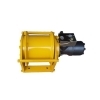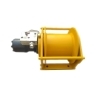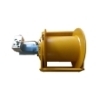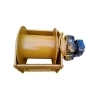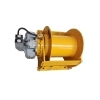By balancing factors like performance, cost, and durability, businesses can make well-informed decisions when selecting a hydraulic winch. As technology progresses, hydraulic winches are expected to become even more efficient, versatile, and reliable, providing even greater capabilities for a wide array of industries. This article by Tool online store aims to offer valuable insights into choosing and using hydraulic winches to enhance operational efficiency and ensure smooth and safe heavy-load handling.
Features and Benefits
Hydraulic winches are highly regarded for their strength, reliability, and versatility. Constructed from durable materials such as steel, they are built to withstand tough environments and heavy loads while maintaining long-lasting performance with minimal upkeep. The hydraulic power system provides superior lifting and pulling capacity, allowing operators to handle even the heaviest loads with ease. Many hydraulic winches are equipped with advanced safety features, such as load-holding brakes and pressure relief valves, to ensure smooth and safe operation. These winches also offer precise control over speed and force, making them suitable for applications requiring careful handling of materials or equipment. Whether used in industrial environments, marine operations, or heavy-duty recovery work, a hydraulic winch is an essential tool for achieving efficient, reliable, and safe lifting and pulling operations.
Hand Winch Price List
Applications of Hydraulic Winch
Hydraulic winches are known for their exceptional power and versatility, making them ideal for a wide range of demanding applications. In the marine industry, hydraulic winches are frequently used for anchoring, mooring, and retrieving heavy loads such as vessels and large equipment. Their ability to handle high-stress operations under challenging environmental conditions makes them indispensable in offshore operations, fishing, and towing.
In the construction industry, hydraulic winches are commonly employed for lifting and positioning heavy materials, such as beams, concrete panels, or large machinery. Their high pulling capacity and efficiency allow for the handling of massive loads with ease, even in remote locations where electricity may not be available. Hydraulic winches are also frequently used in mining and heavy-duty recovery, where powerful winching capabilities are required for tasks like pulling vehicles, equipment, or materials from difficult terrain.
In forestry and logging, hydraulic winches are used to pull large logs and trees, assisting in timber extraction and other tasks in rugged, off-road environments. Similarly, agriculture and logistics sectors rely on hydraulic winches for tasks like pulling heavy machinery, securing cargo, or managing large loads in warehouses.
Due to their portability and power, hydraulic winches are also ideal for use in off-road recovery, helping pull vehicles out of mud, sand, or snow. Their efficiency and durability in such environments make them an essential tool for remote and extreme conditions.
Choosing the Right Hydraulic Winch
Selecting the right hydraulic winch requires careful consideration of factors like load capacity, cable length, and operating conditions. The load capacity is crucial for ensuring safe and effective operation, and hydraulic winches are known for their ability to handle heavy, high-torque tasks. It's also important to consider features like automatic load-holding brakes, corrosion-resistant coatings, and adjustable pressure settings, especially in harsh or marine environments.
For those seeking portability and compactness, smaller hydraulic winches with lower capacity may be ideal for light-duty tasks such as boat or vehicle recovery. However, for heavy-duty industrial operations or marine applications, larger, more robust hydraulic winches with reinforced components are necessary to provide reliable performance under extreme conditions.

